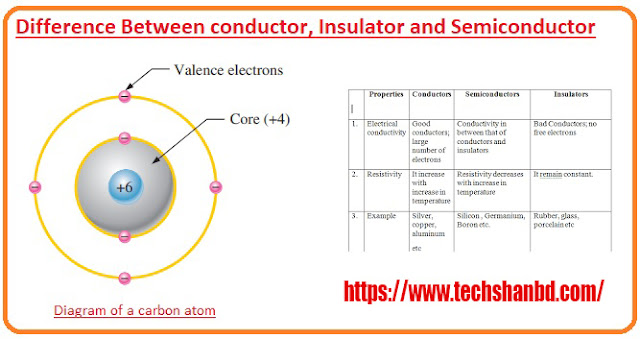Conductive, semiconductor and non-conductive
 |
| Difference-Between-conductor-Insulator-and-Semiconductor | https://www.techshanbd.com/ |
Question-1. What is a conductor? Or, what is a conductor? Or, what is a conductor? Give some examples.
Answer: All the substances through which current can flow easily are called conductive. Example: Generally, all metallic substances are considered to be conductive. In addition, soil, coal, animal bodies act as conductors.
Question-2. What is an insulator? Or, what is non-conductive? Give some examples. Or, what is an insulator?
Answer: Substances through which current cannot flow easily are called non-conductive. Example: Acts as conductor or insulator of rubber, paper, dry wood, glass, etc.
Question-3. What is a semiconductor? An Or, define a semiconductor with examples. Or, write the definition of semiconductor. Or, define semiconductor. Or, write the definition of semiconductor. Or, define a semiconductor. Or, what is a semiconductor?
Answer: All the substances through which a very small amount of current flows, that is, all the substances carrying current. He calls all substances between the conductive and non-conductive semiconductors.
Question-4. Write the names of the six conductors.
Answer: North wet soil, animal bodies, copper, aluminum, brass, and lade.
Question-5. What is the range of resistivity of semiconductor materials?
Answer: 10-5 to 106Ωm.
Question-6. What does a regulator of a conductor depend on? Or, in what ways does the regulator of the conductor depend? Or, on what factors does the conductivity of the conductor depend? * Or, on what date does the conductor's registry depend?
Answer: Resistance depends on the length of the conductor, the area of the cross-section, the material, and the temperature.
Question-7. What is a free electron?
Answer: The electrons of that atom that are lightly bound to the nucleus and which are easily conductive. When they flow through, they are called free electrons.
Question-8. According to electron theory, what is a semiconductor?.
Answer: Resistance depends on the length of the conductor, the area of the cross section, the material and the temperature.
Question-9. What is the unit of relative radiation in the SI system? Or, s. What is the unit of resistivity in the I method?
Answer: Ohmmeter
Question-10. What is the unit of relative radiation in the MKS method?
Answer: Ohm-meter.
Question-11. Write the definition of relative rash. Or, what is resistivity? Or, what is the relative rash?; Or, define relative radiance. Or, define relative rash.
Ans: Two opposite surfaces of a cube of one meter or one centimeter or one-inch arm. The intermediate resistance is called the relative resistance of that substance.
Question-12. If the diameter of a conductor increases 2 times, how many times will its current carrying capacity increase?
Answer: As the radius is proportional to the square of the diameter, the radius will decrease four times and the current-carrying capacity will increase four times. Will get.
Question-13. What is the name of the person through whom electricity can easily flow?
Answer: Conductor. *
Question-14. What is the unit of relative radiation in the CGS system?
Answer: Ohm-centimeters (52-cm).
Question-15. Does the resistance of the insulator vary with increasing heat?
Answer: It decreases.
Question-16. What happens to the radius when the diameter of the conductor is reduced by half?
Answer: 4 times.
Question-17. What do you mean by relative conductance?
Answer: Conductors of two opposite surfaces of a cube 1 m long, 1 m wide, and 1 m high are called relative '* conductors'.
Question-18. What is the subject of the conductor's radiation?
Answer: Depending on the length, cross-section, material, and temperature of the conductor.
Question-19. Write the units of relative radius. [Or, write the unit of relative rash.
Answer: M. K. S method 2m .. C.G.S Foco 12-cm. F.P.S foco 12-inch 71 12-ft.
Question-20. In the case of Radha, what will be the change in the value of A?
Answer: The resistance (R) of the conductor will decrease.
Question-21. What are conductors and insulators?
Answer: Conductors: Substances through which electricity can easily pass are called conductors. Examples: Copper, Aluminum, Leah, Saina, and Silver. . Insulators: Materials that cannot conduct electricity at all are called insulators. * Says. Such as glass, porcelain, rubber, and paper.
Question-22. Write the names of the six non-existent.
Answer: porcelain, rubber, plastic, ebonite, mica, dry wood.
Question-23. Write the names of the six semiconductors?
Answer: Silicon, Germanium, Selenium, Carbon, Arsenic, Antimony.
Question-24. What is a valence electron?
Answer: The electrons in the last orbit of an atom are called valence electrons.
Question-25. What is a closed electron?
Answer: All the electrons in an atom that have a strong bond with the nucleus are called closed electrons.
Question-26. According to electron theory, what is a conductor?
Answer: According to the electron theory, the number of electrons in the outer chamber of all matter is less than 4, They are called conductors.
Question-27. According to electron theory, what is non-conductive?
Answer: Matter that has 4 electrons in the outer cell of the atom is called non-conductive.
Question-28. If the length and cross-section of the conductor are known, then the resistor of the conductor can be determined by any formula: Is done?
Answer: R=ρ*L/A ohm.
Read More Related Post: click hear
#NayeemEva





0 Comments